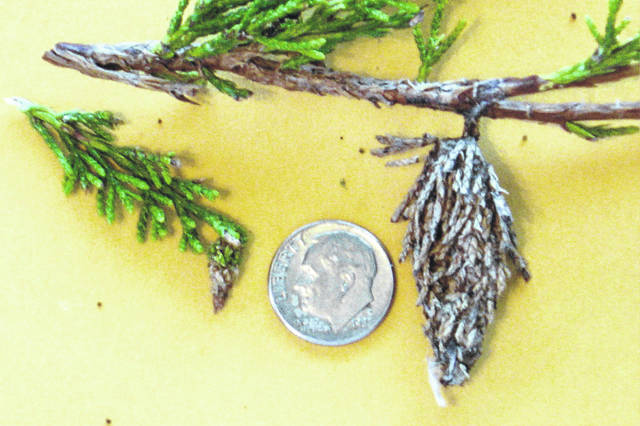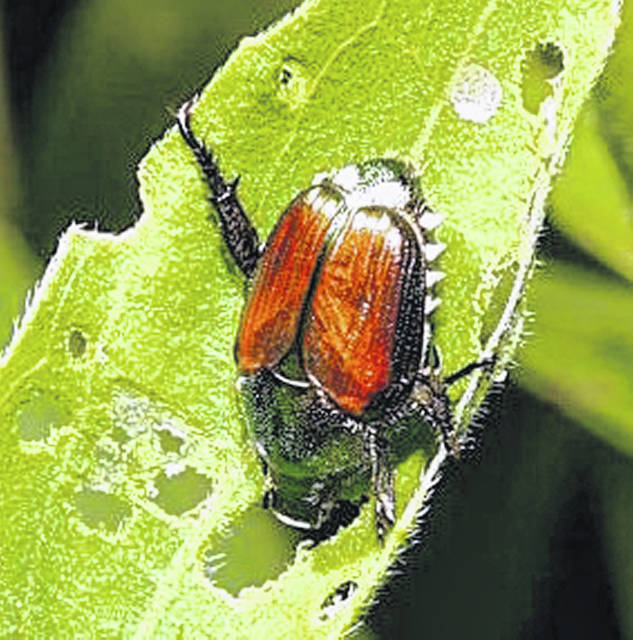



With the beginning of summer, our yearly battle with several insect pests begins. Two are particularly problematic – bagworms and Japanese beetles. Both insects can do considerable damage to our trees and other plants, but a little knowledge can help us deal with each successfully.
Bagworms
Bagworms, not to be confused with eastern tent caterpillars and fall webworms that create net-like webs between the branches of primarily broadleaf trees, create cocoons that somewhat resemble tiny pine cones made up of the material from the plants they are eating. Bagworms tend to prefer needled trees such as arborvitae, cedar, and pine; however, they also feed on broadleaf trees. They began to hatch out about mid-June and started feeding and creating their cocoons. In early stages these cocoons look like tiny dunce caps, and with close observation you can see them moving along the branches. The worms continue to eat and grow until about mid-August, when the larvae mature. Then they permanently fasten their one to two-inch long bags to a branch and prepare to pupate.
As with many insect pests, control is most effective on young larvae. For those wishing to avoid strong chemicals, the bacterium “Bt” (Bacillus thuringiensis) is effective if used by the end of June, after all the eggs have hatched. If last year’s infestation did considerable damage, start Bt applications as soon as feeding is noticed, and then make a second application at the end of June. Unfortunately, it is probably now too late for that, so we need to use one of several stronger insecticides including carbaryl (Sevin), diazanon, acephate (Orthene), and bifenthrin (Talstar) that are also labeled for bagworms (check the label for bagworms and the kind of tree). Again, these must be used while the larvae are still feeding and moving about in their bags. The host plants must be drenched to ensure that the spray reaches the innermost foliage. Late June and early July are the best times to apply these chemicals. Waiting until the bags are permanently attached in August, means hand-picking is about the only effective treatment. If you do hand-pick the bags, crush or burn them; do not just drop them on the ground. Left unchecked, bagworms can potentially kill a ten-foot arborvitae in two or three years. Find more detailed information in OSU fact sheet HYG-2149 “Bagworm and Its Control.”
Japanese beetles
These destructive little critters started arriving in late June. They are a metallic copper-green color and slightly larger than a pea. OSU fact sheet ENT-46 “Japanese Beetle” gives all the details, but here are some quick tips.
Watch for the first beetles that act as scouts and produce a congregation pheremome (scent) that attracts others. Hand-picking and drowning these first arrivals in soapy water may lessen the numbers. The traps you see in gardening supply displays may be somewhat useful for monitoring, but they are not especially effective for control. In fact, they may attract more beetles to the area where they are placed, and these beetles may stop to feed first. Unfortunately, among their favorite plants are roses, Japanese and Norway maples, crabapples, and plum and cherry trees. Actually, they feed on about 400 different plants. If you want to use traps, set them as far away from the plants you wish to protect as possible. Several chemicals, including acephate (Orthene) and carbaryl (Sevin), are labeled for control of adult beetles. If feeding is heavy, repeat applications every five to ten days may be needed (read the label!). To protect bees and other desirable pollinators, avoid applying these chemicals directly on flower blooms.
The larval stage of Japanese beetles and other beetles takes the form of white grubs that feed in the root zone of lawns. Grubs also attract skunks and racoons that dig up the turf searching for food. Controlling these grubs may help reduce this damage to turf and reduce the number of future adult beetles. Milky spore bacterial disease has not proven very effective in Ohio, and parasitic nematodes have been only marginally effective. The most effective treatment for white grubs is using lawn chemicals containing the active ingredients imidacloprid (Merittm) or halofenozide (Mach2tm). Applied in June and July, both of these chemicals should last throughout the grub season. To be effective they must reach the root zone of the lawn by being watered in with at least one-half inch of water. These chemicals are not inexpensive, so if beetle and grub damage has not been a problem in the past, you may wish to wait and see if a serious problem develops later this year.
For more information about insect pests and other gardening questions, contact Shelby County Master Gardeners at [email protected]. Specimens can also be dropped off at the OSU Extension office, 810 Fair Road, during business hours Tuesday through Friday.





